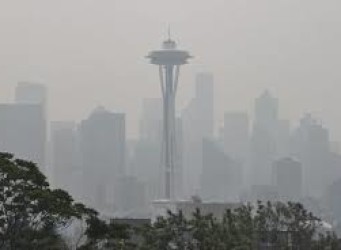The urgency of fighting to limit the affects of climate change is becoming quite clear in the consequences that are already occurring. In the last post I described the impact to real estate that is near the ocean coastlines. Continuing on the same theme this article describes just some of the consequences from forest fires that are becoming more frequent and much bigger.
-
Air Quality Health Alerts cautioning people to stay inside and not exercise outside.
-
Limit your driving.
-
Delayed Flights.
-
Suspended school outdoor sports and activities.
-
Smoke-related health symptoms include coughing, scratchy throat, irritated sinuses, headaches, stinging eyes and runny nose. Those with heart disease may experience chest pain, irregular heartbeats, shortness of breath and fatigue.
Hard to See, Hard to Breathe: US West Struggles with Smoke
SEATTLE (AP) — Smoke from wildfires clogged the sky across the U.S. West, blotting out mountains and city skylines from Oregon to Colorado, delaying flights and forcing authorities to tell even healthy adults in the Seattle area to stay indoors.
As large cities dealt with unhealthy air for a second summer in a row, experts warned that it could become more common as the American West faces larger and more destructive wildfires because of heat and drought blamed on climate change. Officials also must prioritize resources during the longer firefighting season, so some blazes may be allowed to burn in unpopulated areas.
Seattle’s Space Needle was swathed in haze, and it was impossible to see nearby mountains. Portland, Oregon, residents who were up early saw a blood-red sun shrouded in smoke and huffed their way through another day of polluted air. Portland Public Schools suspended all outdoor sports practices.
Thick smoke in Denver blocked the view of some of Colorado’s famous mountains and prompted an air quality health advisory for the northeastern quarter of the state.
The smoky pollution, even in Idaho and Colorado, came from wildfires in British Columbia and the Northwest’s Cascade Mountains, clouding a season that many spend outdoors.
Portland resident Zach Simon supervised a group of children in a summer biking camp who paused at a huge water fountain by the Willamette River, where gray, smoky haze obscured a view of Mount Hood.
Simon said he won’t let the kids ride as far or take part in as many running games like tag while the air quality is bad.
“I went biking yesterday, and I really felt it in my lungs, and I was really headachy and like, lethargic,” Simon said Monday. “Today, biking, you can see the whole city in haze and you can’t see the skyline.”
One of Colin Shor’s favorite things about working in the Denver area is the view of the high peaks to the west. But that was all but gone Monday.
“Not being able to see the mountains is kind of disappointing, kind of sad,” he said.
Forest fires are common, but typical Seattle-area weather pushes it out of the way quickly. The latest round of prolonged smoke happened as hot temperatures and high pressure collided, said Andrew Wineke, a spokesman for the state Ecology Department’s air quality program.
It’s a rare occurrence that also happened last year, raising concerns for many locals that it may become normal during wildfire season. Wineke said climate change is expected to contribute to many more fires.
“The trend is clear. You see the number of forest fires increasing, and so there’s going to be wildfires,” Wineke said. “There’s going to be smoke. It’s going to be somewhere.”
The Federal Aviation Administration said airplanes bound for the Sea-Tac International Airport, Seattle’s main airport, may be delayed because of low visibility.
In Spokane, air quality slipped into the “hazardous” range. Thick haze hung over Washington’s second-largest city, forcing vehicles to turn on their headlights during the morning commute.
The air quality was so bad that everyone, regardless of physical condition or age, will likely be affected, according to the Spokane Regional Clean Air Agency.
In California, wind blew smoke from several wildfires into the San Francisco Bay Area, where haze led authorities to issue an air quality advisory through Tuesday. They suggested people avoid driving to limit additional pollutants in the air and advised those with health problems to reduce time outdoors.
Health officials say signs of smoke-related health symptoms include coughing, scratchy throat, irritated sinuses, headaches, stinging eyes and runny nose. Those with heart disease may experience chest pain, irregular heartbeats, shortness of breath and fatigue.
Patients at Denver’s National Jewish Health, a respiratory hospital, were reporting worsening symptoms, hospital spokesman Adam Dormuth said.
In Portland, six tourists from Lincoln, Nebraska, posed for a photo in front of the Willamette River with the usual Mount Hood backdrop shrouded in haze. The group of siblings and friends rented an RV and drove in to visit a sister who recently moved to the area.
“We are disappointed that we can’t see the mountains and the whole city, because our relatives live here and tell us how pretty it is, and we’re missing it,” Bev Harris said. “We’re from tornado alley, and we don’t have wildfires. It’s a different experience.”
___



